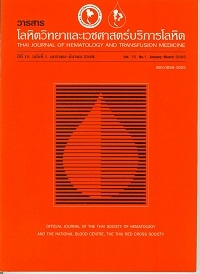การศึกษาผลของระยะเวลาในการเก็บตัวอย่างเลือดต่อการแสดงออกของ CD59 บนเม็ดเลือดที่วิเคราะห์ โดย flow cytometry
คำสำคัญ:
ฺBlood storage, CD59 expression, Paroxysmal nocturnal hemoglobinuriaบทคัดย่อ
บทคัดย่อ : การวิจัยนีศึกษาถึงผลของระยะเวลาในการเก็บตัวอย่างเลือดต่อการวิเคราะห์การแสดงออกของ CD59 บนเม็ดเลือดแดงและแกรนูโลไซต์ (granulocyta) โดยใช้ flow cytometry เพื่อตรวจหาเม็ดเลือดที่ขาด CD59 (PNH cell) โดยการวิเคราะห์การแสดงออกของ CD59 บนเม็ดเลือดแดงที่ใช้ EDTA และ heparin เป็นสารกันเลือดแข็ง และการวิเคราะห์การแสดงออกของ CD59 บนแกรนูโลไซต์ที่ใช้ heparin เป็นสารกันเลือดแข็ง ตัวอย่างเลือดที่นำมาศึกษาได้มาจากคนปกติ, ผู้ป่วย aplastic anemia (AA), ผู้ป่วย myelodysplastic syndrome (MDS), ผู้ป่วย lymphoma กลุ่มละ 10 ราย และผู้ป่วย paroxysmal nocturnal hemogiobinuria (PNH) 13 ราย ทำการศึกษาโดยเก็บตัวอย่างเลือดไว้ที่อุณหภูมิห้อง ที่ระยะเวลา 0 ชั่วโมง, 24 ชั่วโมง และ 48 ชั่วโมง และวิเคราะห์เปอร์เซ็นต์ของเม็ดเลือดที่มีการแสดงออกของ CD59 บนเม็ดเลือดแดงและแกรนูโลไซต์ (%CD59 positive erythrocyte และ %CD59 positive granulocyte) ไม่พบความแตกต่างกันของเปอร์เซ็นต์ดังกล่าวในแต่ละช่วงเวลาอย่างมีนัยสำคัญทางสถิติ (paired t-test, p>0.05) แต่พบว่า %CD59 positive granulocyte บางตัวอย่างเลือดที่เก็บไว้นาน 48 ชั่วโมง มีเปอร์เซ็นต์ต่างไปจากตัวอย่างเลือดที่ตรวจ ภายใน 24 ชั่วโมง (-1%) เมื่อวิเคราะห์ %CD59 positive erythrocyte โดยใช้สารกันเลือดแข็ง EDTA เปรียบเทียบกับ heparin พบว่าไม่มีความแตกต่างกันอย่างมีนัยสำคัญทางสถิติ (t-test, p>0.05) ดังนั้นสรุปได้ว่าตัวอย่างเลือดที่ใช้ EDTA หรือ heparin เป็นสารกันเลือดแข็งเหมาะสมสำหรับส่งวิเคราะห์การแสดงออกของ CD59
บนเม็ดเลือดแดงยังห้องปฏิบัติการต่างสถานที่ โดยระยะเวลาของการเก็บเลือดจนถึงเวลาวิเคราะห์ไม่เกิน 48 ชั่วโมงสำหรับการวิเคราะห์การแสดงออกของ CD59 บนแกรนูโลไชต์นั้น สารกันเลือดแข็งที่หมาะคือ heparin และควรทำการวิเคราะห์ภายใน 24 ชั่วโมง หลังการเก็บตัวอย่างเลือด ทั้งนี้ปริมาณเลือดที่ต่ำที่สุดที่ใช้ในการวิเคราะห์คือ 2 มิลลิลิตร
Downloads
เอกสารอ้างอิง
Hall C, Richards SJ, Hillman P. The Glycosylphosphathidylinosital Anchor and Paroxysmal Nocturnal Haemoglobinuria/Aplasia Model. Acta Haematol 2002;108:219-30.
Luzzatto L. Paroxysmal Nocturnal Hemoglobinuria. International Society of Haematology 1996:120-7.
Oelschlaegel U, Besson I, Arnoulet C, et al. A standardized flow cytometric method for screening paroxysmal nocturnal hemoglobinuria(PNH) measuring CD55 and CD59 expression on erythrocytes and granulocytes. Clin Lab Haem 2001;23:81-90.
Kinoshita T. Overview of Paroxysmal Nocturnal Hemoglobinuria: Molecular Genetics. In : Omine M, Kinoshita T, eds. Paroxysmal Noctumal Hemoglobinuria and Related Disorders. Springer, 2001:3-7.
Hall SE, Rosse WF. The use of monoclonal antibodies and flow cytometry in the diagnosis of paroxysmal nocturnal hemoglobinuria. Blood 1996;87:5332-40.
Meletis J, Terpos E, Samarkos M, et al. Detection of CD55 and/or CD59 Deficient Red Cell Populations in Patients with Aplastic Anemia and Myelodysplastic Syndrome. Leukemia and Lymphoma 1999.
Luzzatto L, Hillmen P. Laboratory methods used in the investigation of paroxysmal nocturnal hemoglobinuria (PNH). In : Dacie JV, Lewis SM, eds. Practical Haematology. 8" ed. Churchill Livingstone 1995.
Nishimura J, Hirota T, Kanakura Y, et al. Long-term support of hematopoiesis by a single stem cell clone in patients with paroxysmal nocturnal hemoglobinuria. Blood 2002:99:2748-51.
Terpos E, Michali E, Meletis Chr, et al. "PNH-LIKE" Red Cell Populations in Patients with Anemia of Different Etiology. Oslo 1998.
วันชัย วนะชิวนาวิน, เกรียงศักดิ์ ภักดีสุวรรณ. Paroxysmal Nocturnal Hemoglobinuria. วารสารโลหิตวิทยาและเวชศาสตร์บริการโลหิต 1995;5:54-62.
Meletis J, Terpos E.Recent insights into the pathophysiology of paroxysmal nocturnal hemoglobinuria. Med Sci Monit, 2003;9:RA161-72.
Nathalang O, Chuansumrit A, Prayoonwiwat W. Rapid screening of PNH red cell populations using the gel test. Southeast Asian J Trop Med Public Health 2003;34:887-90.
Richards SJ, Rawstron AC and Hillmen P. Application of flow cytometry to the Diagnosis of Paroxysmal Nocturnal Hemoglobinuria. Cytometry 2000;42:223-33.
Pakdeesuwan K, Wanachiwanawin W, Siripanyapinyo U, Pattanapanyasat K, Wilairat P, Issaragrisil S. Immunophenotypic discrepancies between granulocyte and erythroid lineages in peripheral blood of patients with paroxysmal nocturnal haemoglobinuria. European Journal of Haematology 2000;65:8-16.
จารุวรรณ โชคคณาพิทักษ์. การเปรียบเทียบค่าเฉลี่ยของประชากร 2 กลุ่ม. ใน: อรุณ จิรวัฒนกุล, บรรณาธิการ. ชีวสถิติ. ภาควิชาชีวสถิติและประชากรศาสตร์ คณะสาธารณสุขศาสตร์ มหาวิทยาลัยขอนแก่น, 2542:144-59.
Vittorio R. The molecular basis of paroxysmal nocturnal hemoglobinuria. Haematologica 2000;85:82-7.
Parker CJ. Molecular Basis of Paroxysmal Nocturnal Hemoglobinuria. Stem cell 1996;14:396-411.
Wanachiwanawin W, Piyawattanasakul N, Visuthisakchai S, Issaragrisil S. Nature of PNH Clones in Aplastic Anemia. In : Omine M, Kinoshita T, eds. Paroxysmal Nocturnal Hemoglobinuria and Related Disorders. Springer 2001:229-33.
Borowitz MJ. Flow Cytometry Testing in PNH. How Much is Enough? Cytometry 2000;42:221-2.
สุรพล เกาะเรียนอุดม, กิตติพงศ์ รุ่งเรืองธนะกิจ, วัชระ กสิณฤกษ์, ชัยยศ คุณานุสนธิ์, โกวิทย์ พัฒปัญญาสัตย์. การบริหารคุณภาพโฟลไซโทเมทรี: การวิเคราะห์หาประชากรย่อยของเซลล์ลิมโฟไซต์. กรุงเทพฯ: ชมรมโฟลไซโทเมทรีแห่งประเทศไทย, 2541:68-9.
Pakdeesuwan K, Wilairat P, Wanachiwanawin W. Paroxysmal nocturnal hemoglobinuria (PNH) : From Basic Research to Clinical Points of View. Mahidol Journal 1997;4:29-34.
Dunn DE, Tanawattanacharoen P, Boccuni P, et al. Paroxysmal nocturnal hemoglobinuria cells in patients with bone marrow failure syndromes. Annal Int Med 1999131:401-8.
Nakao S, Wang H, Chuhjo T. Clinical Significance of Increase PNH-Type Cells in the Peripheral Blood of Patients with Aplastic Anemia and Refractory Anemia. In : Omine M, Kinoshita T, eds. Paroxysmal Nocturnal Hemoglobinuria and Related Disorders. Springer, 2001:129-37.
ดาวน์โหลด
เผยแพร่แล้ว
ฉบับ
ประเภทบทความ
สัญญาอนุญาต

อนุญาตภายใต้เงื่อนไข Creative Commons Attribution-NonCommercial-NoDerivatives 4.0 International License.



